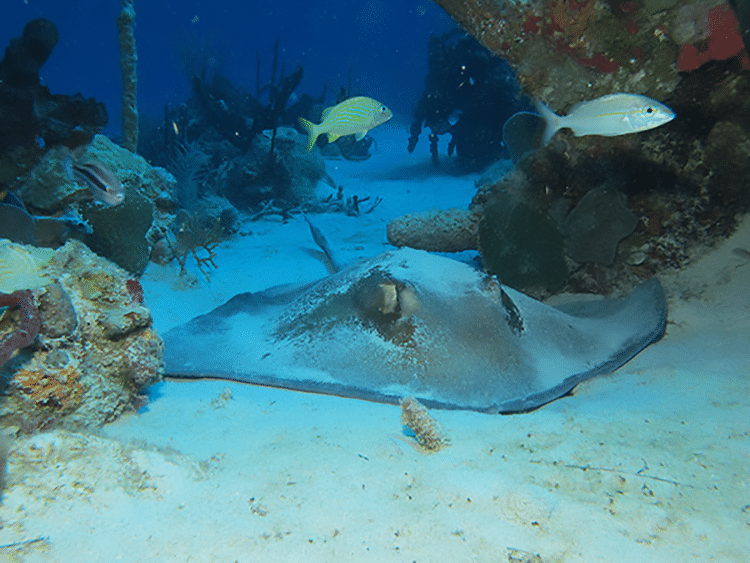Access to St. Croix, the largest of the U.S. Virgin Islands, is easy since it’s a U.S. territory and no passport is required. However, access to the beauty and diversity of life under the waters that surround it requires more effort. You must be a certified scuba diver. Of course you can see plenty of sea life by donning a mask and snorkeling, but as I found out when I became certified, it’s not the same. Although I was anxious about learning to dive, I was able to accomplish each skill, step by step, and being PADI-certified (one of several certifying agencies in the U.S.) has been life changing. The hours spent under the sea, floating weightless amid a world of colorful fish, sponges, and coral gardens, have been some of the most memorable of my life.
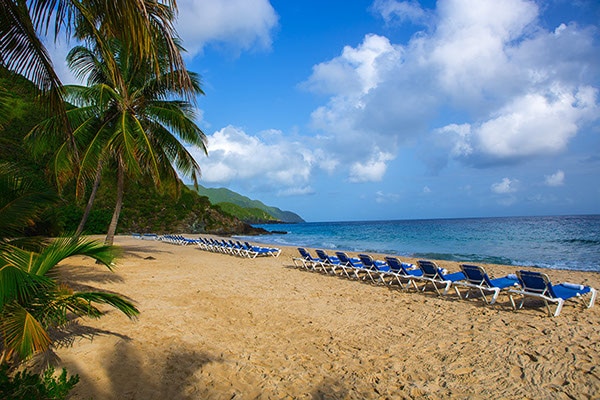
I first visited St. Croix 20 years ago when I did my first night dive under Frederiksted’s pier. It was the perfect destination for a relatively new diver. There are few places in the Caribbean where you can plan dives on a shipwreck, a reef or a wall and then do a night dive under a pier all in one day. I recently returned there with a group that included two friends learning to dive and three seasoned divers. From our base at the Renaissance Carambola Beach Resort, we scheduled dives with three of the island’s top dive operators.
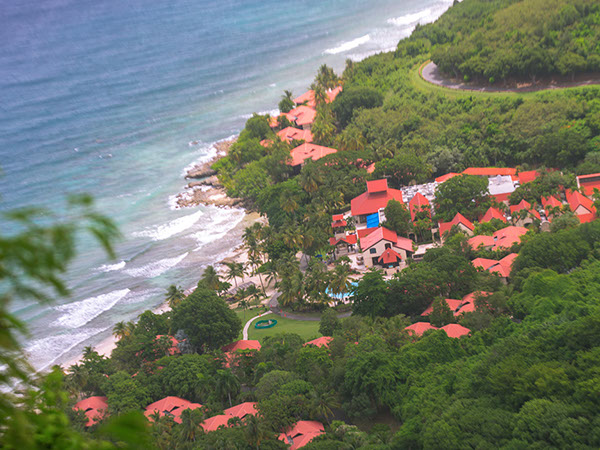
After settling into our beachfront suites, plans to “get wet” the next morning were confirmed. We arrived at Dive Experience’s shop in Christiansted to pick up our equipment—mask, fins, buoyancy compensator (BC) vest, regulator, and wetsuit. By 9:30 a.m. we were headed to Salt River Canyon’s West Wall, a sheer drop-off teeming with life and ideal for both novice and advanced divers. Upon reaching the site, we made a giant stride entry into the gin-clear water from Dive Experience’s custom-designed dive boat. One of the island’s most experienced divers, Michelle Pugh, owner of Dive Experience and a member of the Women Divers Hall of Fame, guided us. She made sure we didn’t miss seeing the Southern stingrays hiding in the sandy bottom, the sea turtles that seemed to follow us throughout our dive, and small creatures untrained eyes can miss, like spindly-legged arrow crabs clinging to a sea fan and tiny shrimp, no bigger than a fingernail, blending into the coral.
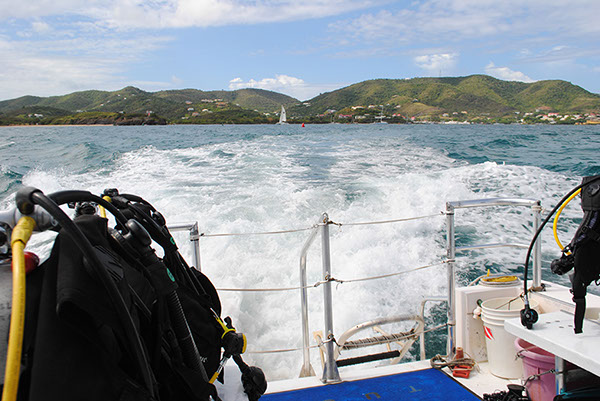
The following day, we entered the water from the white sand shore at Cane Bay, one of the premier dive sites in the Caribbean. After a short surface swim (BC’s inflated, finning on our backs) we reached the point where our Cane Bay Scuba guide indicated it was time to descend. On our way to the sloping wall where we would stay for the majority of our dive, we passed by a coral nursery, one of several restoration projects undertaken by the Nature Conservancy in St. Croix and St. Thomas to re-establish coral in damaged areas of the reef. The underwater nursery is one of two locations off St. Croix where nursery-raised staghorn coral specimens, a fast-growing yet threatened variety of coral, have been attached to steel tree-like structures on concrete pedestals buried in the sand. As we continued past the nursery, we could see why Cane Bay’s reef was selected for its prime growing conditions. We swam past sea fans, brain coral, and purple tube sponges, a thriving reef inhabited by a myriad of sea life, including stingrays, turtles, lobster, reef squid and schools of blue tang and yellowtail snapper.
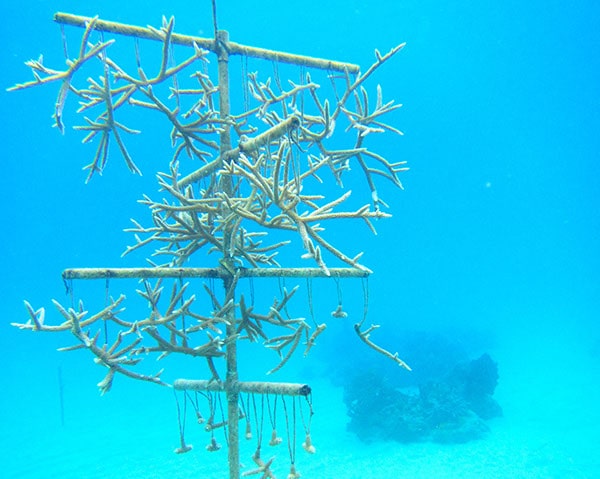
For me the night dive, which we booked through the Sweet Bottom Dive Center based at our resort, was the highlight of the week. Before setting up our equipment and donning wetsuits in preparation for entering the water from the Frederiksted Pier, Sweet Bottom co-owners Mel and Greg Gapen gave us our briefing. They explained what we could expect to see and how to use our flashlights to locate each other and maneuver underwater in the dark. As we began slowly descending to a sandy bottom, the sun was setting, reflecting shades of gold and orange on the surface. Under the pier our flashlights illuminated the pilings, which were encrusted with fluorescent yellow and red corals, as well as creatures rarely seen in the light of day—seahorses, an octopus, a sleeping green sea turtle inside a large barrel sponge, and a line of red cushion sea stars that crawled across the sand until disappearing into the darkness.
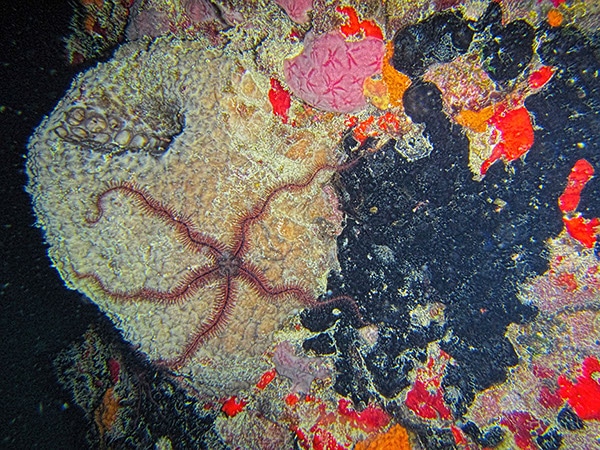
The two novices participating in the Discover Scuba program had received instruction in the basics earlier in the week—how to set up their equipment, clear water from their masks, and equalize the pressure in their ears when making a shallow descent to around 20 feet. They were not able to join us for the night dive but participated in the shore dive at Cane Bay to a depth of 30 feet.This abbreviated course is a great way to decide if you’d like to pursue taking the full certification course in your home city or on a future tropical trip.
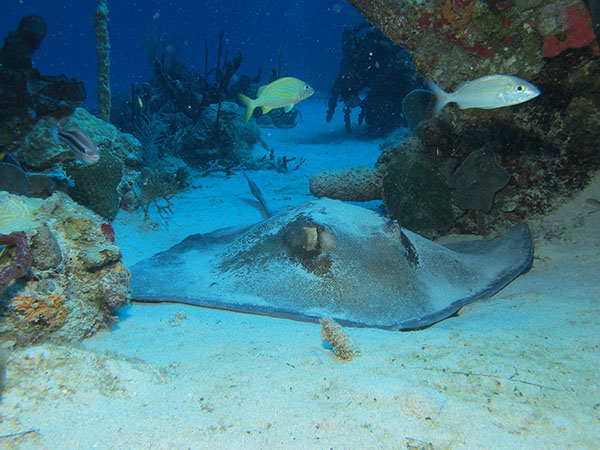
We ended the week with a Caribbean Sea Adventures excursion by boat to Buck Island Reef National Monument, recognized for its underwater snorkeling trail spread over 704 acres. President John F. Kennedy established the area as a protected reef in 1962. Although hurricanes have damaged parts of the reef in recent decades, it was fun to follow the trail, reading the underwater plaques identifying coral species along the way. The 176-acre uninhabited island itself is a great place to picnic and hit the beach, especially on the western shore’s Turtle Beach, rated among the world’s most beautiful beaches by National Geographic.
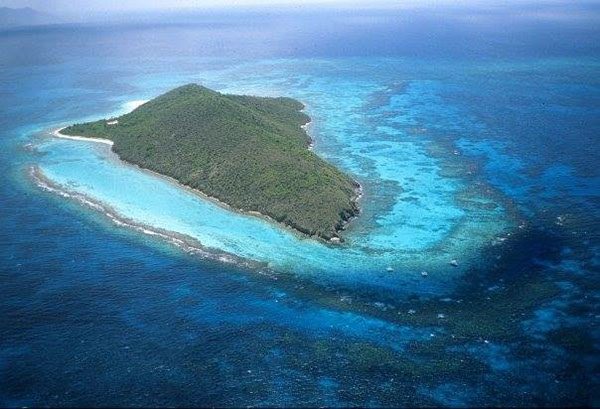
The green sea turtles we saw on every dive were a welcomed sight, since they are designated as threatened by the Endangered Species Act. Another endangered turtle species, the giant leatherback, may also be witnessed during nesting season, when the large, lumbering turtles come ashore to lay their eggs on one of several turtle nesting beaches on the island. A rare daytime sighting made news when one came ashore to dig its nest as a wedding was taking place on Carambola’s beach. Now that’s a wedding crasher no one will ever forget!
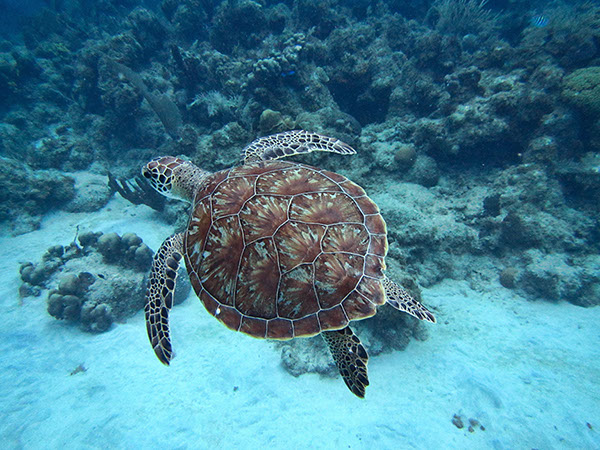
Where to Stay:
Renaissance St. Croix Carambola Beach Resort & Spa—Located at the foot of a rainforest nestled on white sand beaches, guests can play golf at nearby Carambola Golf Club, or snorkel and scuba dive right off the beach. Three restaurants, 150 spacious rooms with kitchenettes, large screened-in porches, and free wireless internet. Estate Davis Bay, St. Croix, USVI. 800-228-9290; 340-778-3800; www.carambolabeach.com
The Buccaneer—Family-owned and operated since 1947 and recognized as a Historic Hotel of America, the hotel’s 138 rooms and suites are situated on 340 acres, formerly the site of a sugar factory and later a cattle ranch. Its three beaches, three restaurants, two pools, tennis center and spa make it a self-contained destination resort.5007 Estate Shoys, Christiansted, St. Croix, USVI; 800-255-3881; 340-712-2100; www.thebuccaneer.com
Tamarind Reef Resort—Located on the north shore of St. Croix between Christiansted and Buck Island, this family-friendly resort features 40 beachfront rooms fronting a quiet, secluded beach, ideal for snorkeling. Two restaurants, pool, tennis courts, spa and 154-slip marina. 5001 Tamarind Reef, Christiansted, USVI; 800-619-0014; 340-718-4455; www.tamarindreefresort.com
Where to Eat:
Savant—One of the island’s finest eateries, Savant’s creative chef serves up a mix of Caribbean, Thai and Mexican cuisines, incorporating local fish and meats. Specialties include cassava crusted fish and Thai green coconut curry. Dine in the courtyard for romantic, Old World ambience. Hospital St, Christiansted, St Croix, USVI; 340-713-8666; www.savantstcroix.com
Rum Runners—Open for breakfast, lunch and dinner seven days a week from its waterfront location at the Hotel Caravelle, Rum Runners has an extensive drink menu, incredibly tasty fish tacos and conch fritters, and the island’s only live lobster tank. 44A Queen Cross St., Christiansted, St. Croix, USVI; 800-524-0410; 340-773-6585; www.rumrunnersstcroix.com
Eat @ Cane Bay—Enjoy lunch, dinner, or just drinks at this casual bar and eatery that is just across the road from Cane Bay’s popular shore diving beach. Check out the blackboard for daily food, wine, beer and drink specials with nightly entertainment. 110C Cane Bay, St. Croix, USVI; 340-718-0360; www.eatatcanebay.com
Harvey’s—For an “eat where the locals eat” experience, stop in for delicious West Indian cuisine including local fish in Creole sauce served with rice and plantains, ribs, chicken, goat stew, and conch in butter sauce at this family-owned and operated restaurant. 11B Company St., Christiansted, St. Croix, USVI; 340-773-3433
What to See & Do:
Buck Island Reef National Monument—This uninhabited 176 acre island and over 700 acres of protected waters surrounding it make up one of the most popular attractions a short boat ride from St. Croix. Hiking trails, white sand beaches and underwater snorkeling trails make it an ideal day trip for relaxation and exploration.
Christiansted National Historic Site—A seven-acre waterfront park focuses on Christiansted’s past, when it was capital of the Danish West Indies. Sites include the 18th century Fort Christiansvaern, built to protect the town from pirate attacks, and the Danish West India and Guinea Company Warehouse, where Alexander Hamilton worked as a young man. Its courtyard hosted some of the largest slave auctions in the Caribbean. Admission: $2
Scuba Diving—Book dives or diving instruction with one of the following PADI 5-star dive centers:
- Dive Experience—1111 Strand Street, Christiansted, St. Croix, USVI; 800-235-9047; Direct: 340-773-3307. www.divexp.com
• Cane Bay Scuba—110C Cane Bay, USVI; 800-338-3843; Direct: 340-718-9913.
• Sweet Bottom Dive—Renaissance St. Croix Carambola Beach Resort, Estate Davis Bay, St. Croix, USVI; Direct:340-773-3483. www.sweetbottomdive.com
• St. Croix Ultimate Bluewater Adventures—81 Queen Cross St., Christiansted, St. Croix, USVI; 877-567-1367; Direct: 340-773-5994. www.stcroixscuba.com
Snorkel Buck Island Reef—Caribbean Sea Adventures, 59 King’s Wharf, Christiansted, St. Croix, USVI; 340-773-2628; www.caribbeanseaadventures.com
Where to Shop:
Sonya’s—Don’t leave St. Croix without buying a sterling silver hook bracelet from Sonya. The handcrafted hammered-finish bracelets are sized to fit any wrist. Buyers are instructed to position the horseshoe-shaped hook to face inward (toward your heart) if you’re taken, and outward if you’re available. From $60. 1 Company St., Christiansted, St. Croix, USVI; 877-766-9284; 340-773-8924; www.sonyaltd.com
For more information: USVI Tourist Board – www.VisitUSVI.com

